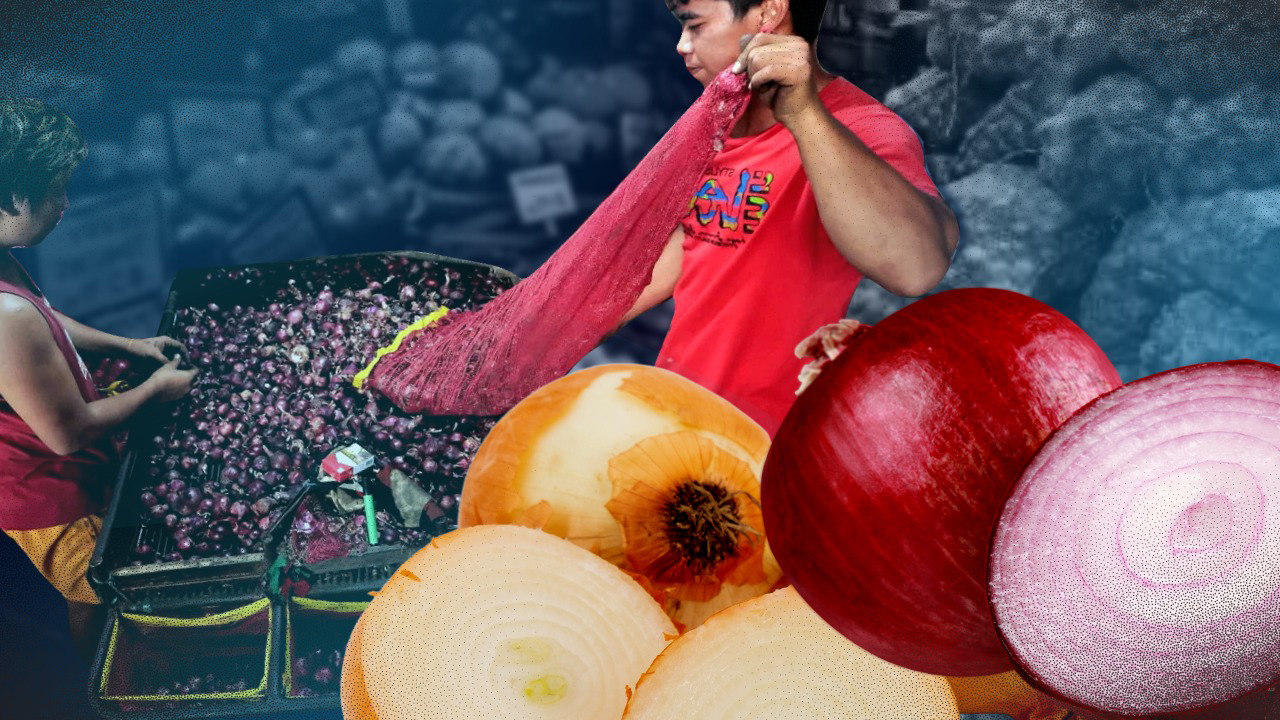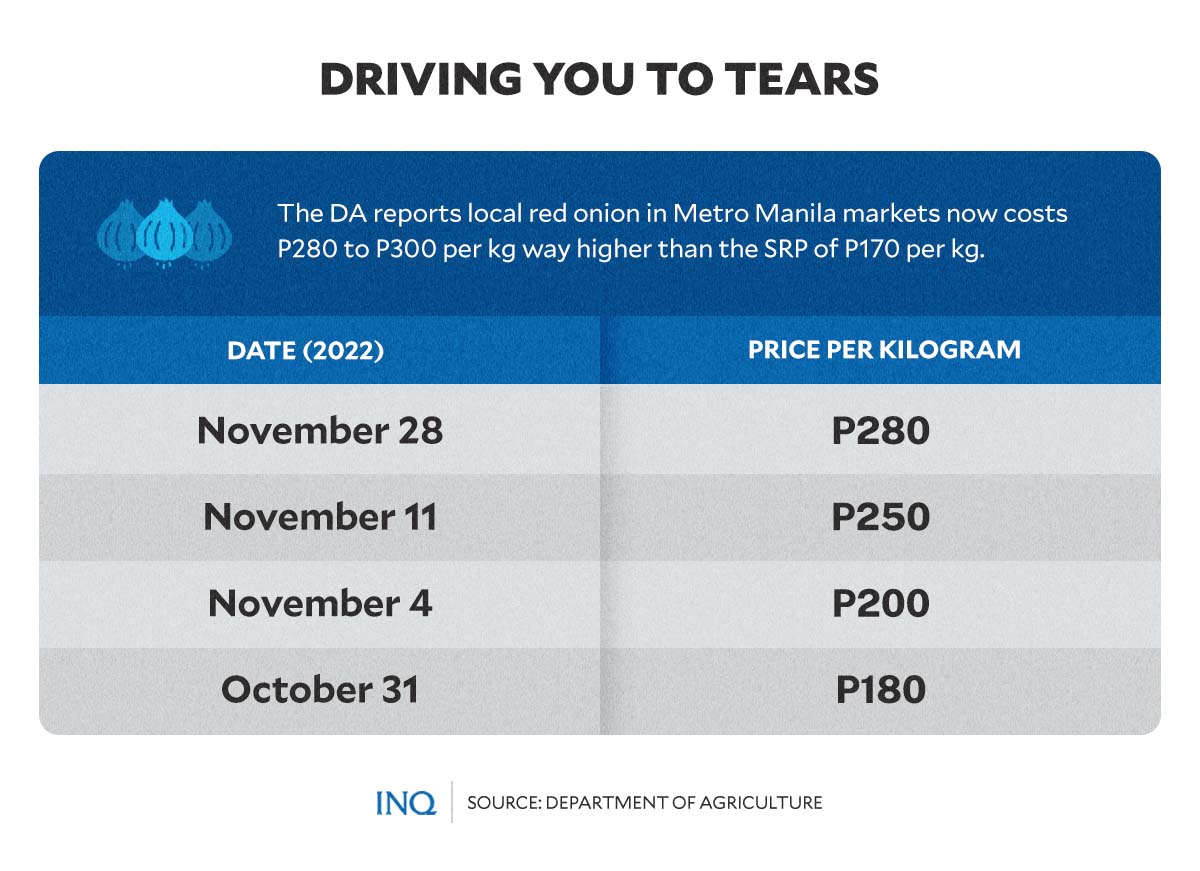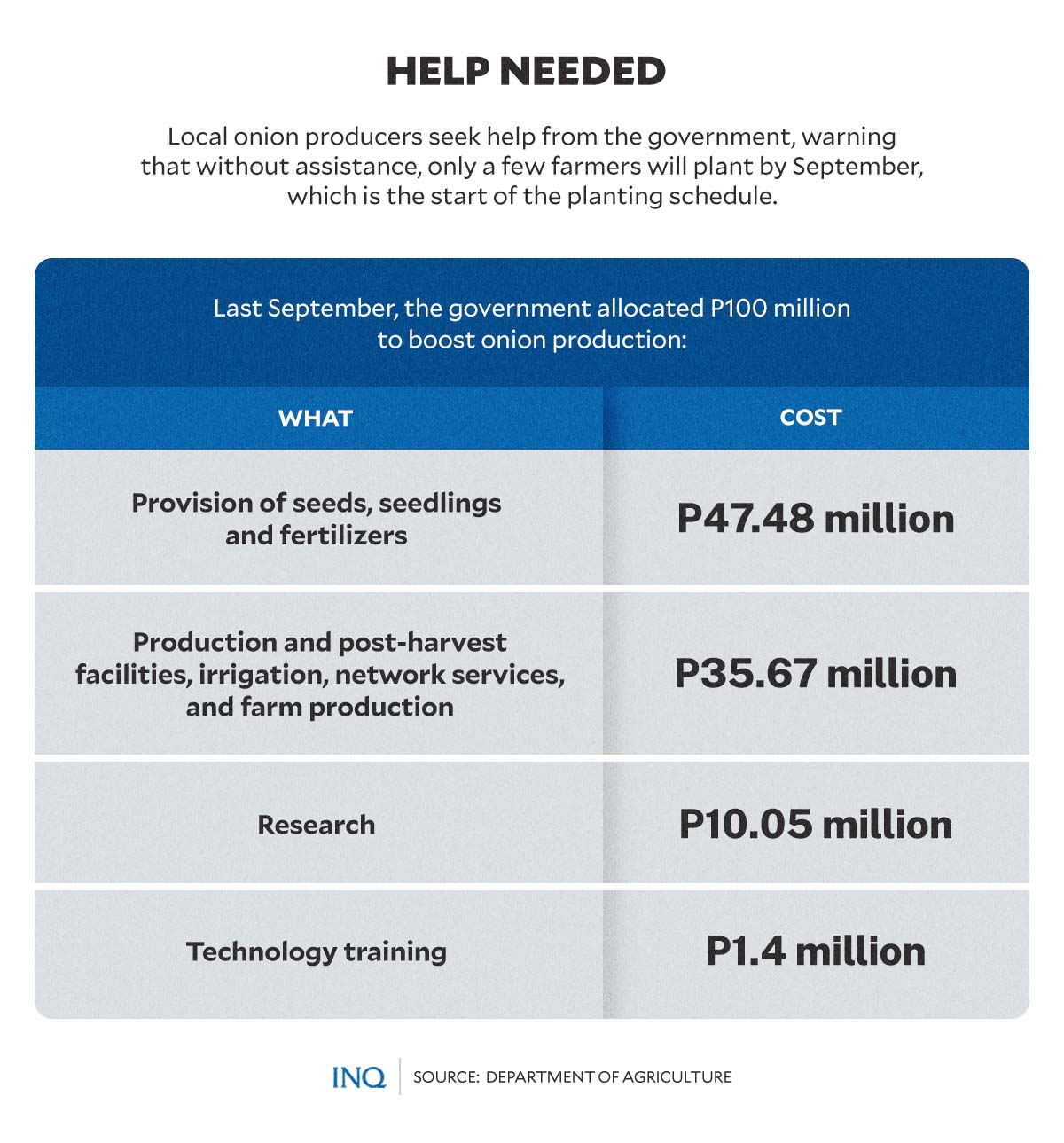P300/kg red onions: Issues beyond just supply

INQUIRER FILE PHOTO
MANILA, Philippines—It was last month when the Department of Agriculture (DA) set a suggested retail price of P170 a kilo for red onions, but two months later, the cost of the commodity, which is a constant in many Filipino dishes, is still rising.
READ: DA sets suggested retail price for red onions
According to data from the DA, a kilo of red onions is now worth P280 to P300 in Metro Manila, way higher than P250 on Nov. 11, P200 on Nov. 4, P180 on Oct. 31, and P140 on Aug. 19. A kilo of red onions was worth P180 a year ago.
How did this happen?
According to the DA, it’s not known yet since it’s still coordinating with the Bureau of Plant Industry to determine the reasons for the steep hike, saying supply is also being checked.
READ: Red onions now selling at P300 per kilogram
But looking back, the DA had stressed that in Central Luzon, Calabarzon, and Mimaropa, which are some of the top onion producing regions in the Philippines, the sufficiency level for red onions fell to 0 percent in July.
Because of this, officials said they were expecting red onions to be scarce until November before recovering to 57 percent by December, when local bulb production is expected to be at 12,416 metric tons.
According to the Philippine Statistics Authority, local onion production declined by 11,000 metric tons last year from its level in 2020. The production in the second quarter, meanwhile, was registered at 82,080 metric tons.
The DA said before the lean months that began in June, the sufficiency level of bulbs was high, with 689 percent coverage at best in March, which is the month when onions are harvested.
Should there indeed be a lack of supply, Assistant Agriculture Secretary Kristine Evangelista said local onion producers are expected to begin harvesting between the second and last weeks of December.
She said this could ease the steep pressure on prices: “Right now, we’re looking into the volume of future harvests since, as we know, more supply will help lower or stabilize prices.”
Not self-sufficient
According to the Philippine Onion Industry Roadmap 2021-2025, the Philippines needs to increase its onion production from 229,539 metric tons to 279,270 metric tons to achieve self-sufficiency in onions by 2025.
But Statista, a data consumer company, said the total land area being used for onion production in the Philippines has gone down to 19,300 hectares last year from 19,900 hectares in 2019.

GRAPHIC Ed Lustan
Likewise, local onion producers had stressed that they need assistance from the government, especially when they are affected by pest infestation, saying that without help, many farmers would be discouraged from producing bulbs.
This, as some local onion producers often find themselves at the losing end because of natural disasters hitting their crops and then some traders only buying their produce at P30 a kilo even if red onions are selling at P280 to P300.
Last September, the DA earmarked P100 million to strengthen local onion production, stressing that several interventions will be implemented to boost the bulb industry in the Philippines.
For 2022, the department allocated P47. 48 million for the provision of seeds, seedlings and fertilizers, while P35.673 million was allocated for the establishment of onion production and post-harvest facilities, irrigation services and farm equipment.
At least P10.048 million was also allocated for onion production research activities, while a total of 1.4 million was allocated to finance a package of technology training, the DA said.

GRAPHIC Ed Lustan
It said onion production schedule starts in September at the earliest until March, while harvesting may start in December until June, the reason that Evangelista said more supply is expected next month.
Farmers’ lives drying up
But while it’s easy to blame the lack of supply for the steep hike in the cost of red onions, it can be recalled that in April, Anakpawis took the DA to task for failing to implement decisive measures.
The DA’s “failure,” according to the farmers’ alliance, led to low farm gate prices and non-profitability of produce, leaving hundreds of local onion farmers with thousands worth of losses.
Rafael Mariano, national chairperson of Anakpawis, said “importation has always been a scourge to local industries because cheap imports pull down the value of our local products.”
RELATED STORY: Farmers to sell onions to fast-food chains
“Similar to the devastating impacts of importation measures to rice farmers and fisherfolk, onion farmers are at the losing end courtesy of the government’s commitment to trade liberalization,” he said.
Last Nov. 16, the DA said the government was considering the importation of 7,000 metric tons of red onions to stop the spike in the cost of the commodity, stressing that if there was indeed a shortfall, there is a need to import.

GRAPHIC Ed Lustan
But looking back in 2020, Sen. Imee Marcos called on the DA to make certain that local harvests would not be affected whenever it plans to import red onions because of lack of supply.
This, as she expressed fears that a glut in imported red onions would end up rotting in government warehouses, without bringing down the price of the farm produce. Local onion farmers are expected to start harvesting by next month.
As previously told by some onion producers in Nueva Ecija to ABS-CBN News, they are not against importation if it is really needed, however, they hoped that it be small and limited to how much is needed.














